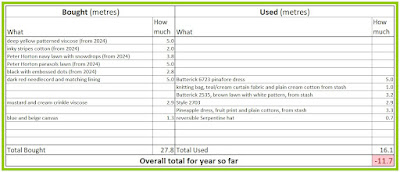I already have several straw sunhats, which I wear regularly, but I wanted something which I could just fold up and put in my bag. Unfortunately, I have a strong aversion to bucket hats (one of my many clothing prejudices, but that's another story!), so my options were rather limited. But then I spotted Susan Young wearing what looked like the Perfect Hat on Instagram, which turned out to be the Serpentine.
All of Elbe Textiles' patterns are PDFs, which are not my favourite thing, but fortunately a hat doesn't run to many sheets of A4. The hat is fully lined, so it's possible to use two different fabrics and make it reversible. Susan had advised me that because of the large brim, stiff or firmly interfaced fabric is key, so I used plain canvas in blue and beige.
 |
| The two fabrics in the brim |
It's a great pattern. There are only three pieces, they fit together perfectly, and the instructions are clear without being long-winded. The only change I made was that rather than sew the band pieces together and then sew around the upper edge as guide for fitting the top, I stay-stitched the pieces before sewing them together. I did the same for the brim pieces, too. But really that was just because that’s how I'm used to constructing garments.
 |
| Stay stitching the band |
One thing I would say is to closely follow the advice about notching seams. There are a lot of curved pieces in this pattern, and taking the time to snip them properly will really help everything to fit together properly and keep the edges smooth.
 |
| The brim seam notched and pressed open |
The clever construction means that the whole thing is machine sewn; there is no hand finishing required. Because I was using such different coloured fabrics there was a lot of changing spools and bobbins, but it was worth it. There were times when there were several layers of fabric to sew through, but my treadle machine coped effortlessly.
And here is the finished hat (or two). Excellent fit, good wide brim, and easy to make. It really is the Perfect Hat.
 |
| Beige hat with blue lining |
 |
| And vice versa |
In fact, it will probably be one of several perfect hats. I have plenty of canvas left over, so I'm thinking of making a couple more with patterned linings/under brims. So hopefully the leftovers on the stashometer will eventually vanish.
 |
| 0.6m left over, but ideally not for long |






























































